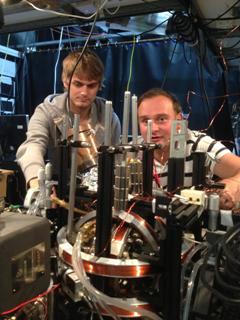Jul 3 2015
Physicists at the University of Sussex have found a way of using everyday technology found in kitchen microwaves and mobile telephones to bring quantum physics closer to helping solve enormous scientific problems that the most powerful of today's supercomputers cannot even begin to embark upon.
 Winfried Hensinger (right) and Dr. Seb Weidt are freezing individual atoms using microwaves. Credit:University of Sussex
Winfried Hensinger (right) and Dr. Seb Weidt are freezing individual atoms using microwaves. Credit:University of Sussex
A team led by Professor Winfried Hensinger has frozen single charged atoms to within a millionth of a degree of absolute zero (minus 273.15°C) with the help of microwave radiation. This technique will simplify the construction of 'quantum technology devices' including powerful quantum sensors, ultra-fast quantum computers, and ultra-stable quantum clocks. Quantum technologies make use of highly strange and counterintuitive phenomena predicted by the theory of quantum physics.
The report "Ground-state cooling of a trapped ion using long-wavelength radiation" was published in Physical Review Letters this week: Here
"The use of long-wavelength radiation instead of laser technology to cool ions can tremendously simplify the construction of practical quantum technology devices enabling us to build real devices much faster," said Professor Hensinger.
Once quantum technology is harnessed into practical devices it has the potential to completely change everyday life again - just as computers have already done. Quantum technologies may one day revolutionise our understanding of science answering open questions of biology and solving the origin of the universe and other puzzles as well as allowing for a revolution in sensing, time keeping and communications.
"By taking advantage of simple well developed technology we have be able to create a remarkably robust and simple method, which is expected to provide a stepping stone for this technology to be integrated into a breadth of different quantum technologies spanning from quantum computers to highly sensitive quantum sensors," said Professor Hensinger.
Freezing atoms puts them into the lowest possible energy and is a step towards harnessing the strange effects of quantum physics, which allow objects to exist in different states at the same time. "Besides finding an easy way to create atoms with zero-point energy, we have also managed to put the atom into a highly counter intuitive state: where it is both moving and not moving at the same time," said Professor Hensinger.